nokia 4A0-106 Exam Questions
Questions for the 4A0-106 were updated on : Nov 21 ,2025
Page 1 out of 15. Viewing questions 1-15 out of 214
Question 1
Which of the following is NOT a viable option when implementing inter-AS VPRN?
- A. An MP-eBGP session between route reflectors in different autonomous systems to exchange IPv4 routes.
- B. An MP-eBGP session between ASBRs to exchange labeled IPv4 routes.
- C. An eBGP session between ASBRs to exchange IPv4 routes.
- D. An MP-eBGP session between ASBRs to exchange VPN-IPv4 routes.
Answer:
A
Question 2
Which of the following about inter-AS model B VPRN is TRUE?
- A. Model B requires the configuration of back-to-back VRFs between the ASBRs in different autonomous systems.
- B. Model B is highly scalable because the VPN-IPv4 routes are neither maintained, nor distributed by, the ASBRs.
- C. There is a dependency between the route target used in different autonomous systems.
- D. Model B supports the exchange of labeled IPv4 routes between ASBRs.
Answer:
D
Question 3
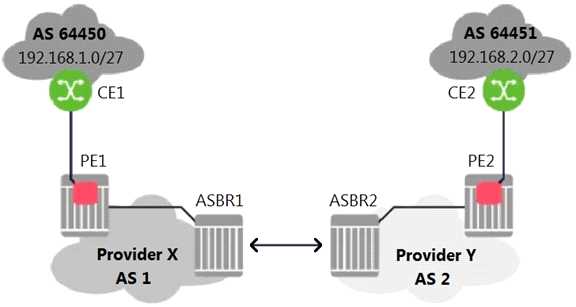
For the inter-AS model B VPRN, which of the following protocols is used to advertise routes between
ASBR1 and ASBR2?
- A. iBGP
- B. eBGP
- C. MP-iBGP
- D. MP-eBGP
Answer:
D
Question 4

The headquarter sites of VPRN 10 and VPRN 20 are part of an extranet VPRN. Which route target(s)
should be imported under the VPRN 10 service on router R1?
- A. target:65100:1 only
- B. target:65100:1 and target:65100:2
- C. target:65100:1 and target:65100:3
- D. target:65100:1, target:65100:2, and target:65100:3
Answer:
D
Question 5
Which of the following statements is FALSE when providing Internet access using route leaking
between a VRF and the global routing table?
- A. It is best used when a single VPN is required to provide Internet access, as well as to maintain VPN connectivity between different customer sites.
- B. If there is no requirement for the VRF to contain the full Internet routing table, a default route to the Internet gateway router is sufficient.
- C. Only one interface on the CE is required for both VPN and Internet connectivity.
- D. The Nokia 7750 SR supports route leaking in full mesh and extranet VPRN topologies only.
Answer:
D
Question 6
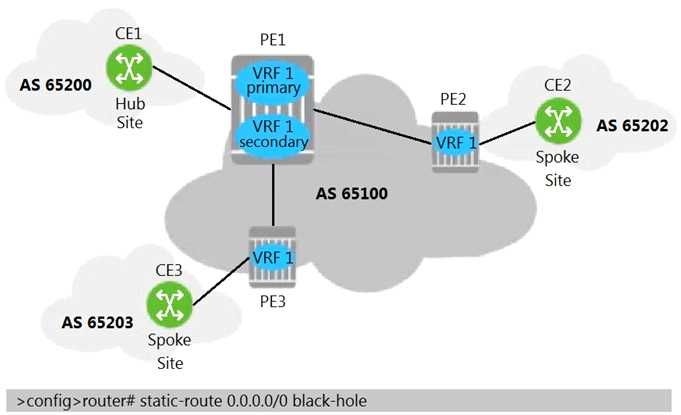
To enable full spoke-to-spoke connectivity for the CE hub and spoke VPRN, on which router(s) should
the displayed static-route be configured?
- A. PE1
- B. CE1
- C. PE2 and PE3
- D. CE2 and CE3
Answer:
C
Question 7
For a Carrier Supporting Carrier (CSC) VPRN where the customer carrier is a BGP/MPLS VPN service
provider, which of the following is TRUE?
- A. The customer carrier network can be a pure IP network.
- B. The customer carrier can provide Layer 2 and Layer 3 services to its end-customers.
- C. If the customer carrier offers VPRN services, PE routers residing in different customer carrier sites must run iBGP between them to exchange IPv4 routes.
- D. If the customer carrier offers VPRN services, the network provider stores the end-customer routes in its CSC VPRN.
Answer:
B
Question 8
Which of the following statements about the control plane in Carrier Supporting Carrier (CSC) VPRN
is FALSE?
- A. The customer carrier does not learn any network provider routes.
- B. The network provider must learn the customer carrier PE and CE system addresses.
- C. Routes exchanged between CSC-CE and CSC-PE are labeled.
- D. The customer carrier PE system addresses are populated in the CSC VRF.
Answer:
B
Question 9
Which of the following statements about Inter-AS model В VPRN is TRUE?
- A. MP-iBGP is used between PE1 and ASBR1 to exchange VPN-IPv4 routes.
- B. eBGP is used between ASBR1 and ASBR2 to exchange IPv4 routes.
- C. MP-eBGP is used between PE1 and PE2 to exchange VPN-IPv4 routes.
- D. MP-eBGP is used between ASBR1 and ASBR2 to exchange labeled IPv4 routes.
Answer:
D
Question 10
For the Inter-AS model C VPRN, which of the following is FALSE when an IP packet is sent from
192.1.1.1 to 192.2.1.1?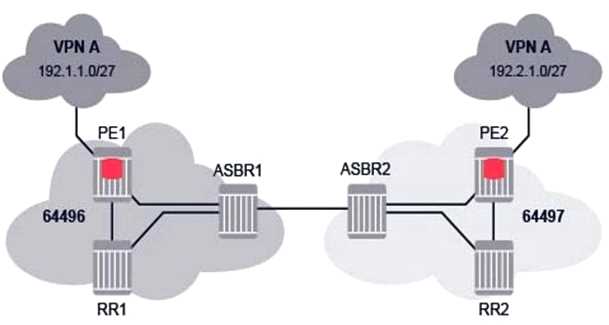
- A. PE1 pushes three labels on the IP packet: a VPN label, a BGP label, and an LDP transport label.
- B. ASBR1 pops the LDP label, swaps the BGP label and forwards the IP packet to ASBR2.
- C. ASBR2 swaps the BGP label and pushes an LDP transport label.
- D. PE2 pops all labels and forwards the unlabeled packet to its destination.
Answer:
B
Question 11
Which of the following statements about inter-AS model C VPRNs is FALSE?
- A. VPN-IPv4 routes are neither held, nor re-advertised, by the ASBRs.
- B. Each ASBR propagates the routes received from its neighbor ASBR as labeled IPv4 routes in its own AS.
- C. ASBRs exchange labeled IPv4 routes for the system addresses of PE routers.
- D. ASBRs exchange customer routes as labeled IPv4 routes.
Answer:
D
Question 12
For the Inter-AS model В VPRN, which of the following statements about the inter-as-label output on
ASBR1 is TRUE?
- A. ASBR1 includes label 131069 in the route update sent to ASBR2.
- B. ASBR1 includes label 131068 in the route update sent to ASBR2.
- C. ASBR1 includes label 131068 in the route update sent to PE1.
- D. ASBR1 includes labels 131068 and 131069 in the route update sent to ASBR2.
Answer:
C
Question 13
For the Inter-AS model В VPRN, which of the following is FALSE when CE2 sends an IP packet to
192.168.1.1?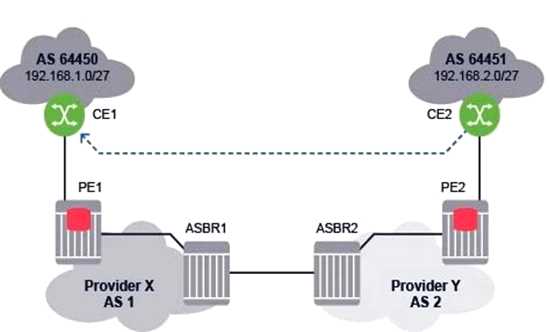
- A. PE2 pushes two labels on the IP packet and forwards it to ASBR2.
- B. ASBR2 forwards the IP packet with one label to ASBR1.
- C. ASBR1 label-switches the packet and forwards it with one label to PE1.
- D. PE1 forwards an unlabeled IP packet to CE1.
Answer:
C
Question 14
For the Inter-AS model A VPRN, which of the following is FALSE when CE2 sends an IP packet to
192.168.1.1?
- A. CE2 forwards an unlabeled IP packet to PE2 via the VPRN interface.
- B. PE2 pushes one label on the IP packet and label-switches it to ASBR2.
- C. ASBR2 forwards an unlabeled IP packet to ASBR1.
- D. ASBR1 pushes two labels on the IP packet and label-switches the packet to PE1.
Answer:
B
Question 15
Which of the following commands produces the output for the inter-AS model B VPRN?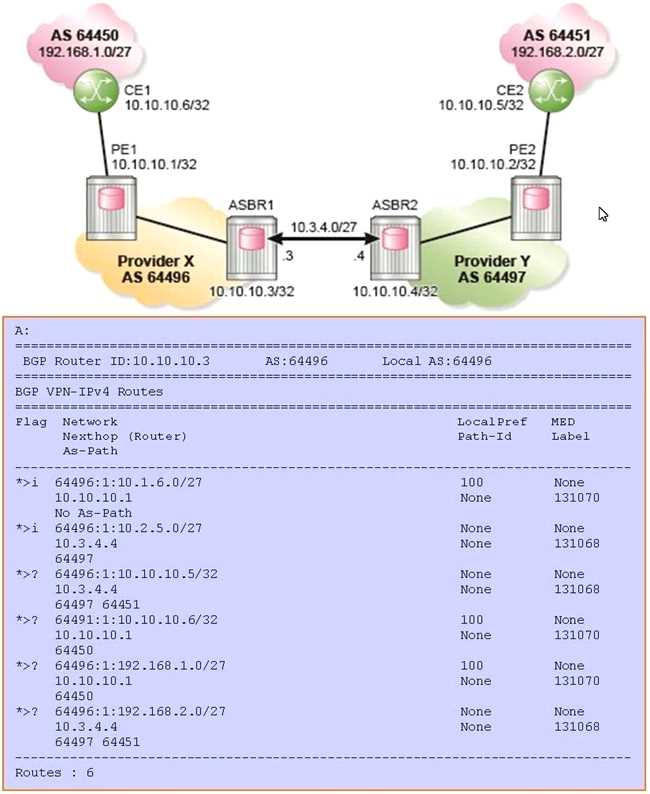
- A. show router 10 bgp routes vpn-ipv4
- B. show router bgp routes
- C. show router bgp routes vpn-ipv4
- D. show router route-table
Answer:
C